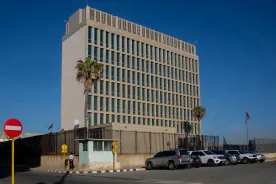January 11, 2025

U.S. intelligence has found no evidence linking a foreign power to the mysterious “Havana syndrome” injuries reported by some U.S. diplomats and other government personnel, though two agencies now say it’s possible a foreign adversary may have developed or even deployed a weapon responsible for the injuries.

The conclusion, which echoes early investigations, follows a review conducted by seven intelligence agencies or departments that examined cases of brain injuries and other symptoms reported by American diplomats and other military and government staffers, who have raised questions about the involvement of a foreign adversary.
In the new assessment released by U.S. intelligence on Friday, five of the seven agencies concluded that it is very unlikely that a foreign adversary was behind the injuries.
Two of the agencies, however, reached a different conclusion, determining that there is a possibility that a foreign power may have developed or even used a weapon capable of causing the reported injuries. Such a device would presumably rely on acoustic energy, microwaves or anther kind of directed energy.
Symptoms that include headaches, balance problems and difficulties with thinking and sleep were first reported in Cuba in 2016 — leading to the label “Havana Syndrome” — and later by hundreds of American personnel in multiple countries.
The Biden administration has faced pressure to investigate following the reports from U.S. personnel of significant brain injuries and other symptoms after being targeted by what some have suggested is an effort to harass and injure Americans working overseas. But officials have been unable to find an explanation.

In the new assessment, the two agencies, which officials did not identify, did not find evidence linking any specific episode to technology developed by Russia or another country but based their findings on understandings of foreign weapon development and capability.
One of the agencies found there was a “roughly even chance” that a foreign government used such a weapon or prototype device in a “small, undetermined” number of cases affecting U.S. personnel.
The other agency determined that while it’s possible that a foreign power has developed such a weapon, it’s unlikely that it has been deployed in any of the cases reported to authorities.
The new findings released Friday represent a “shift in key judgments by some intelligence components” that demonstrates the need for additional investigation, National Security Council spokesperson Sean Savett said in a statement.
“Our focus on these priorities remains unwavering and must continue,” Savett said. “It is vital that the U.S. government continue critical research, investigate credible incidents, and strengthen efforts to provide timely care and long-term clinical follow-up.”
An intelligence official who briefed reporters on the new assessment downplayed the change, noting that the two agencies that held open the possibility that a foreign government was developing or deploying a weapon responsible for the injuries expressed “low confidence” in their findings.
The official, who spoke on the condition of anonymity under rules set out by the Office of the Director of National Intelligence, noted that other national security agencies were more confident in their determination that foreign governments were not involved and that specific intelligence clues found by some U.S. intelligence cast doubt on any foreign involvement.
“There’s no intelligence linking a foreign actor to any specific event,” the official told reporters.